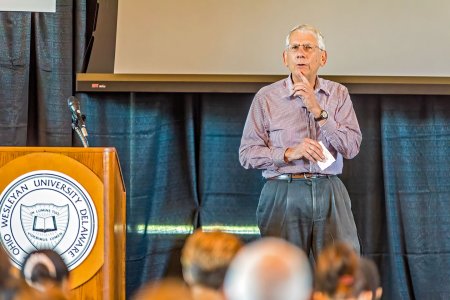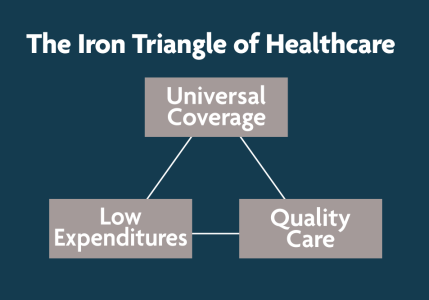Teaching Moments
Life Is a Series of Trade-Offs
By Robert Gitter, Emeritus Professor of Economics
Enjoy this mini-class from a favorite OWU professor who retired last May after 46 years of service to OWU and OWU students.
 One of the most basic and insightful concepts in economics is the idea of trade-offs.
One of the most basic and insightful concepts in economics is the idea of trade-offs.
In general, we face scarcity of some valuable resource and have to make tradeoffs. For example, a farmer might have a field of a certain size and must decide between planting corn or soybeans. The key point is that given the size of the field, growing more corn results in growing less soybeans. There is a trade-off between the two.
(Pop Quiz: For those of you who had Principles of Economics, do you remember what the trade-off is called? Answer below.)
Nothing limits us to just two goods. Given the recent increase in the price of wheat, our farmer might choose to grow that instead of corn or soybeans. We can apply this simple idea to a consumer with a certain level of income choosing between buying milk and gasoline. (As I write this, I am not sure which has a lower price per gallon!)
In my own research, I look at the limited resource as being time, as there are only 24 hours in a day.
We must choose between work that gives us an income, work in the home (including childcare) that produces no income, and leisure, which also produces no income but is usually enjoyable. Thinking like this allows us to better understand an economic reason behind the 60-year rise in women working outside the home; as their potential earnings have increased, many have made trade-offs leading them to forego leisure time.
Although a resource can be scarce, that does not mean to say we can’t get more of it. Although we can’t get more than 24 hours in a day, our farmer could buy additional land and have more corn and more soybeans. But if a larger field is not an option, more corn means less soybeans.
In one of my courses, I taught about the health care system, which has three desirable goals: cover more people, provide quality care, and keep expenses low.
 In general, more of one means less of one of the others. We can cover more people in our health care system, but the result will be either increased cost and/or lower quality care. For example, some nations have universal coverage but the tradeoff is long wait times for some procedures. I call this the Iron Triangle of Health Care.
In general, more of one means less of one of the others. We can cover more people in our health care system, but the result will be either increased cost and/or lower quality care. For example, some nations have universal coverage but the tradeoff is long wait times for some procedures. I call this the Iron Triangle of Health Care.
This is not an argument against universal coverage. Instead, it shows that trade-offs might be made, and the decisions we must make are if the trade-offs are worth it.
It is possible, and we should strive to make those changes that might allow us to have more of one or more of the things we desire without a trade-off.
For example, increases in agricultural technology might allow us to have both more corn and soybeans. A universal measles vaccine can rather inexpensively provide better health to everyone. These solutions are not elusive unicorns, but they aren’t always easy to find.
Congratulations, you traded five minutes scrolling on Facebook for reading this. Please feel free to give this a like. And the answer to the pop quiz? It’s opportunity cost. I hope you remembered, but sorry, I don’t give retroactive extra credit.
